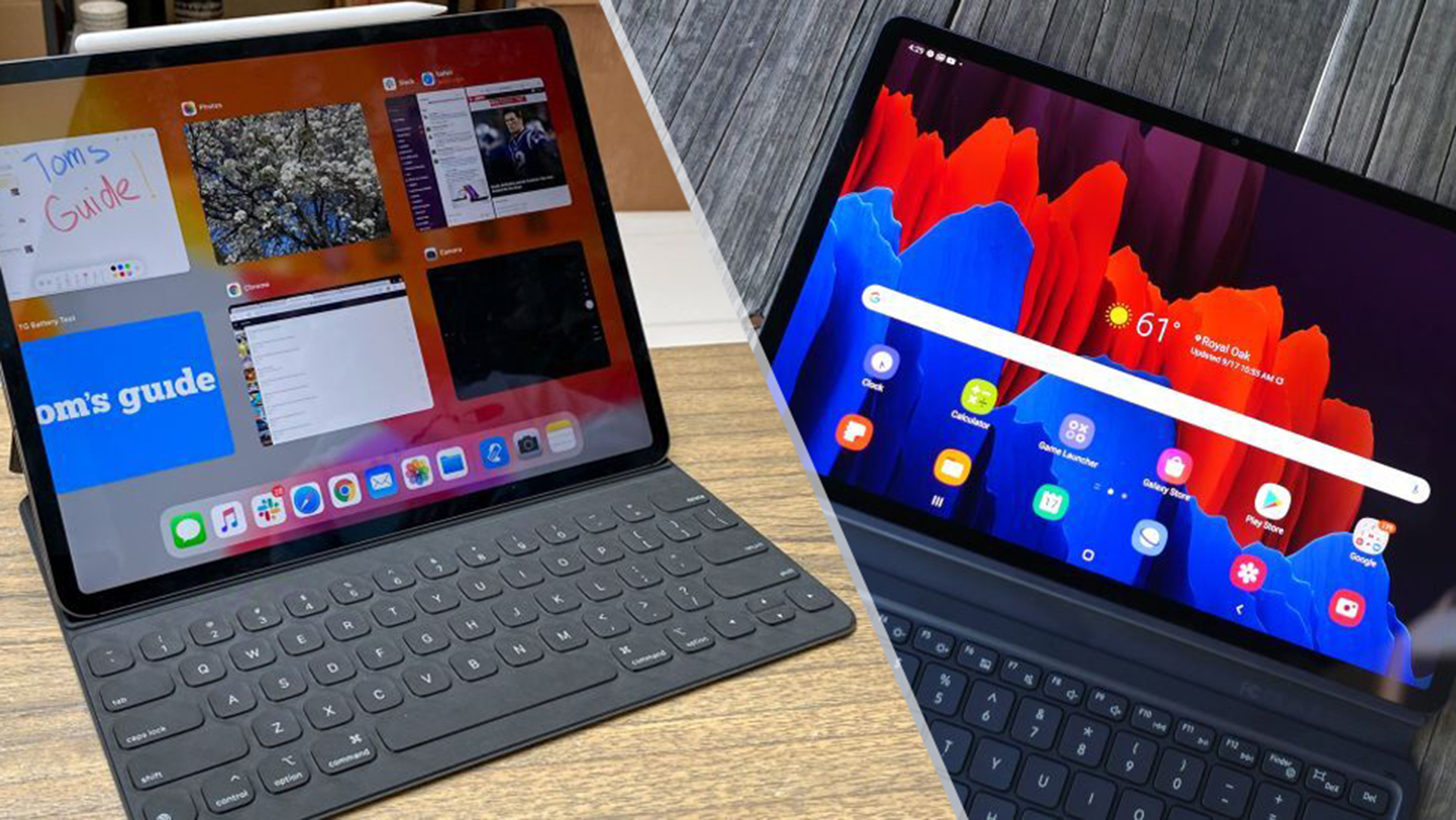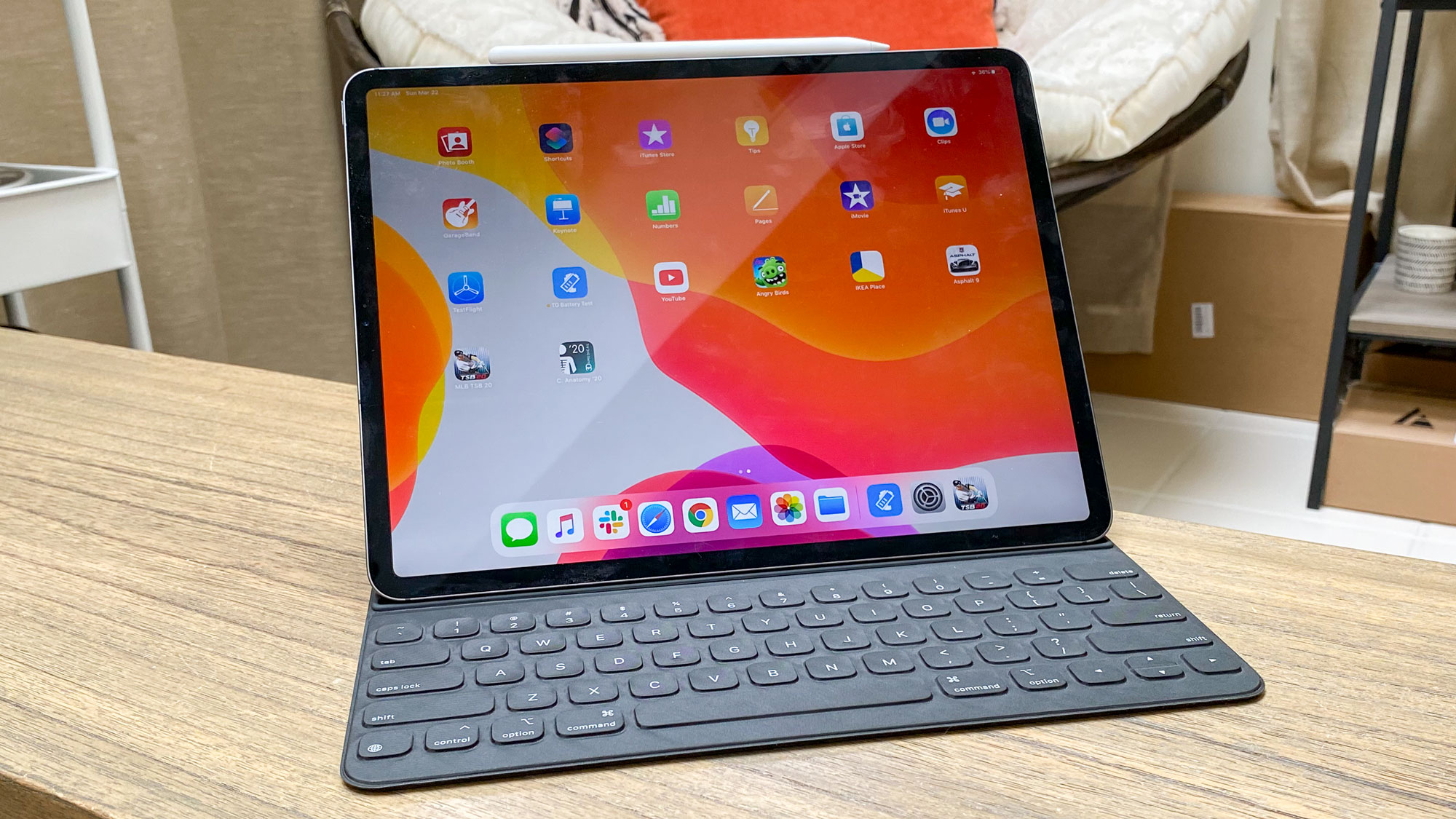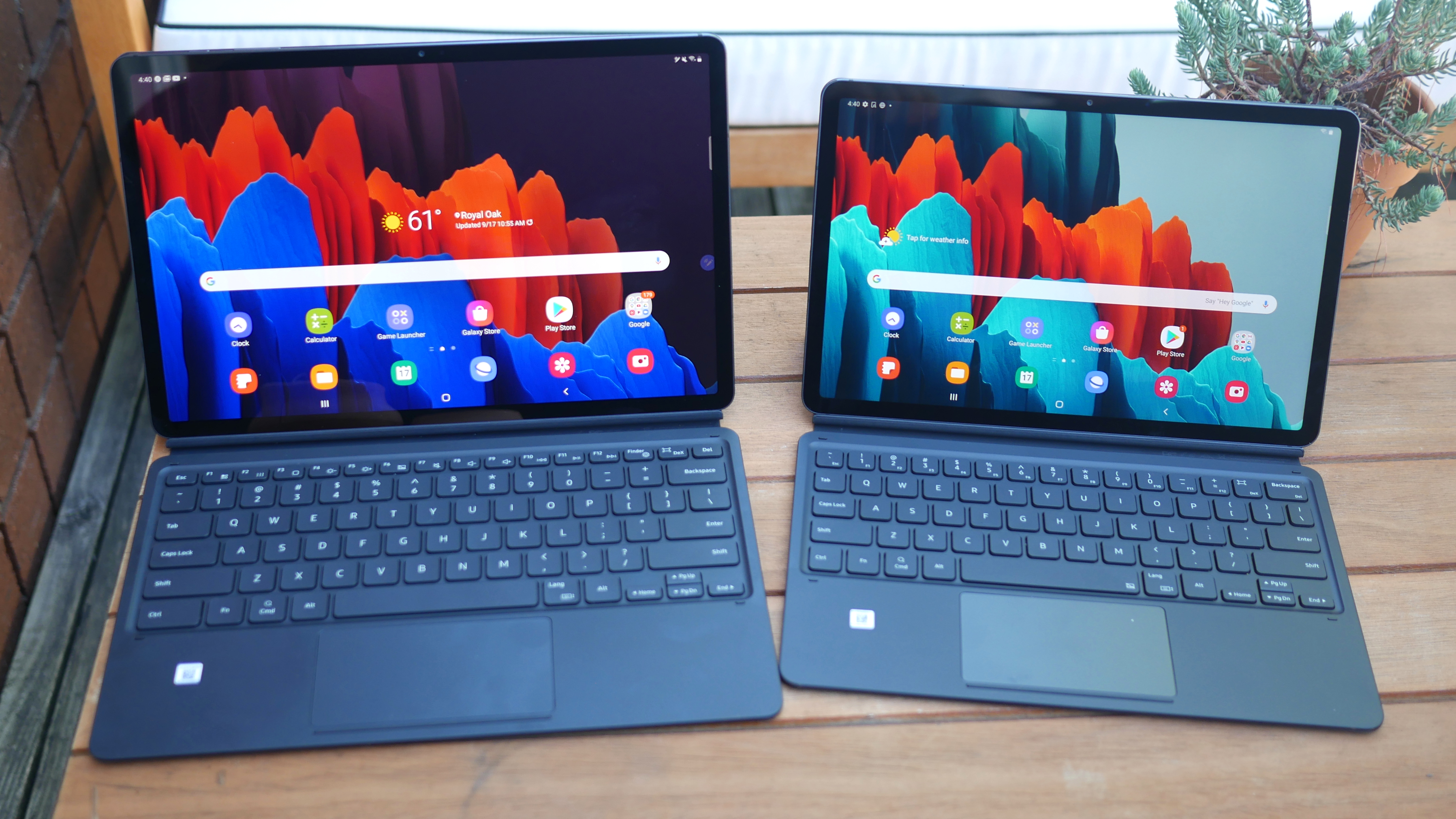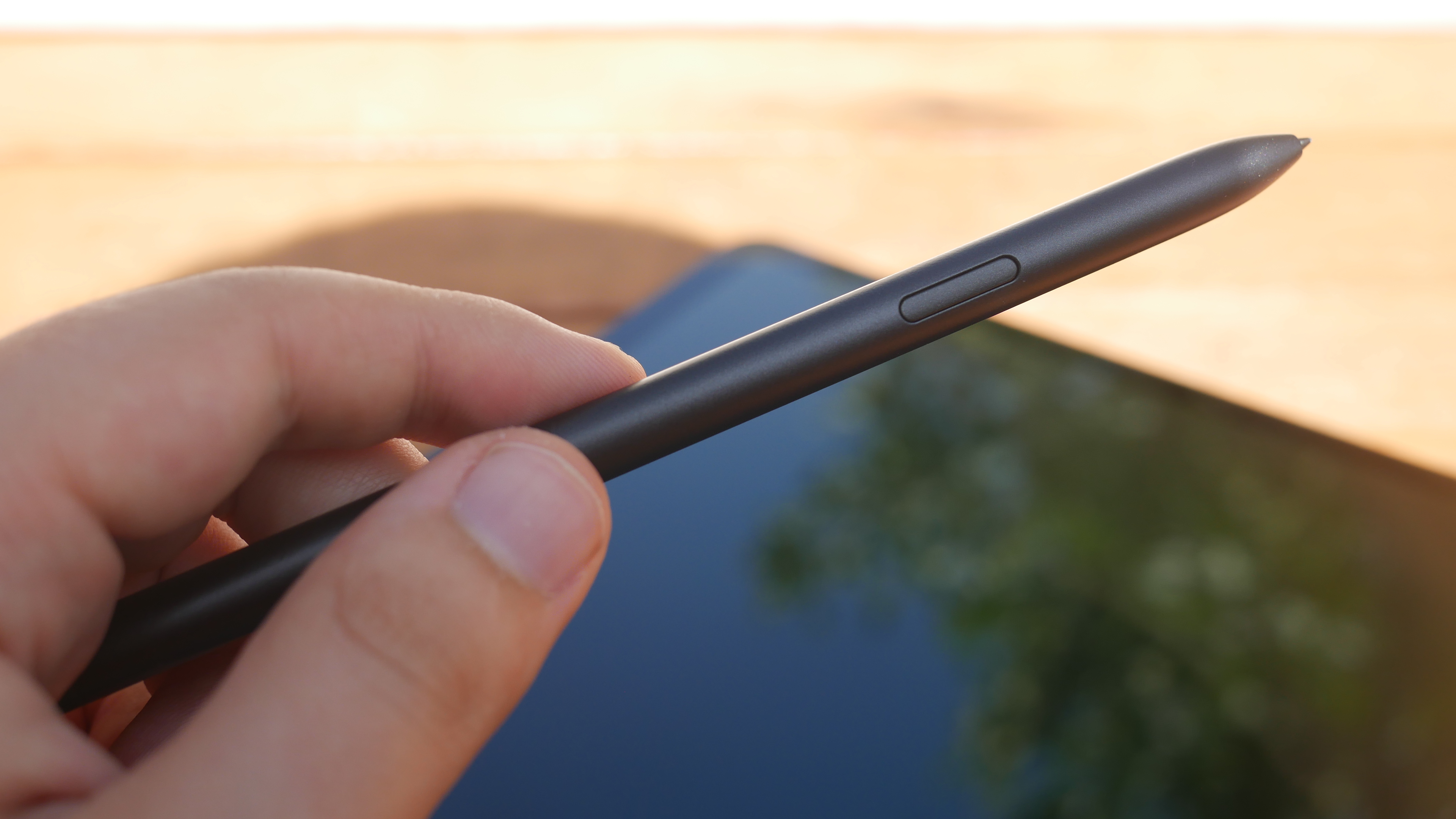Samsung Galaxy Tab S7 Plus vs. iPad Pro: Which tablet is best?
Can the Galaxy Tab S7 Plus dethrone the iPad Pro?

Samsung won't let Apple off easily. While continuing its hard-fought battle against the iPhone with its Galaxy smartphones, Samsung is now going after Apple's flagship tablet, the iPad Pro. To dethrone the king, Samsung has enlisted the Galaxy Tab S7 Plus, a 12.4-inch slate with a class-leading display and suite of modern features, including 5G support.
But dethroning the king of tablets is no easy task. In fact, the iPad Pro doesn't face much competition. Why? For one, few have invested as much in tablets as Apple, the company credited for popularizing the category. Then there's the $799 starting price of the iPad Pro, which can quickly jump into quadruple digits. It's a hard ask for a product only now being considered a primary computing device instead of a laptop backup. And finally, we have to give credit where it's due: Apple has simply produced better products than its rivals.
- Best tablets in 2020
- iPad vs iPad Air vs iPad Pro vs iPad mini: iPad Buying Guide
- Best Microsoft Surface Pro alternatives in 2020
And yet, here we are, Samsung ready to fight another war with Apple on a new battlefield. To be clear, the Galaxy Tab S7 Plus isn't the first of its kind (as the name suggests), but it's the first premium tablet to go after the iPad Pro outside of Microsoft's Surface devices. With a gorgeous 12.4-inch OLED display, excellent accessories and generous connectivity options, Samsung's latest tablet puts up a good argument. But is it really better than the iPad Pro? Read on to find out.
Galaxy Tab S7 Plus vs. iPad Pro: Price and configurations
First things first: we're going to ignore the standard Galaxy Tab S7 to keep this a more apples-to-apples comparison and instead focus on the Tab S7 Plus.
Now we can get right to the bad news: these are some of the most expensive tablets on the market. The Galaxy Tab S7 Plus starts at $849 with a Qualcomm Snapdragon 865+ CPU, 6GB of RAM and 129GB of UFS flash storage.
If you need more RAM, our review unit has 8GB of memory and 256GB of storage but costs a wallet-busting $929. There's even a 512GB model for $1,029 or you can add 5G support to the base model and pay $1,049.
Not to be outdone, the 11-inch iPad Pro starts at $799 for 128GB of storage and goes up to $899 for 256GB. The 512GB model goes for $1,099 while the 1TB version costs $1,299. Opting for the 12.9-inch version drives the price up to $999 for 128GB. Storage pricing is similar for the larger version so you're looking at $1,099 for 256GB of storage, $1,299 for 512GB and $1,499 for 1TB.
Sign up to receive The Snapshot, a free special dispatch from Laptop Mag, in your inbox.
Galaxy Tab S7 Plus vs. iPad Pro: Specs compared
| Row 0 - Cell 0 | Samsung Galaxy Tab S7 Plus | iPad Pro (12.9-inch) |
| Price | $929 (starting at $849) | $999 |
| CPU | Snapdragon 865+ | A12Z Bionic |
| Display | 12.4 inches (SUPER AMOLED), 2800 x 1752-pixel | 12.9 inches, 2732 x 2048-pixel |
| RAM | 6GB, 8GB | 6GB |
| Storage | 128GB, 256GB, 512GB | 64GB, 256GB, 512GB, 1TB |
| Battery | 8:51 | 10:16 |
| Weight | 1.3 pounds | 1.4 pounds |
| Size | 11.22 x 7.28 x 0.22 inches | 11 x 8.5 x 0.2 inches |
Galaxy Tab S7 Plus vs. iPad Pro: Design
Thin metal slates with narrow display bezels -- this is the iPad Pro and Tab S7 Plus in a nutshell. Both tablets will make you feel better about the money you spent once you get your hands on them. The machined aluminum feels solid and everything down to the alignment of the speaker grilles is precisely cut.
In many ways, the Galaxy Tab S7 and iPad Pro look and feel similar. They're large aluminum rectangles with rounded corners and a USB-C port on the bottom edge when positioned vertically.

There are a handful of minor aesthetic differences. Among the more obvious is the camera module. While found on the top-left corner of the back of both devices, the iPad Pro has a rounded square module for its dual rear cameras whereas the Galaxy Tab S7 Plus' module has an elongated oval shape under which a black magnetic pen holder strip extends. In comparison, the magnetic strip that holds and charges the optional Apple Pencil is located on the top edge of the iPad Pro.
Interestingly, the front-facing camera is located on the longer bezel of the Galaxy Tab S7 unlike the iPad Pro, where it's positioned on the narrower edge. This suggests the iPad Pro is meant to be held vertically whereas the Galaxy Tab S7 has a horizontal orientation.
Apple keeps the iPad Pro buttoned-up so your only color options are Space Gray and Silver. Samsung didn't go as crazy with colors this year, offering the Galaxy Tab S7 in Mystic Bronze, Mystic Silver and Mystic Black.

Both tablets support biometric login, but only the Galaxy Tab S7 gives you options for facial recognition via an IR camera and a fingerprint sensor embedded beneath the OLED display. The iPad Pro offers only Face ID.
One design element that sets these tablets apart from others is the thin display bezels. Only a thin strip of black border surrounds their displays, resulting in a more immersive viewing experience and a reduced footprint.
At 11.2 x 7.3 x 0.2 inches, the Galaxy Tab S7 Plus is about as thin and slightly lighter than the 12.9-inch iPad Pro, which measures 11 x 8.5 x 0.2 inches and weighs 1.4 pounds.
Winner: Draw
Galaxy Tab S7 vs. iPad Pro: Display
Move over Retina, I only have eyes for AMOLED. The Galaxy Tab S7's 12.4-inch, 2800 x 1752-pixel AMOLED display is the best panel you'll find on any tablets. Colors burst off the screen and dark scenes are inky black. It makes the iPad Pro's 12.9-inch, 2732 x 2048-pixel look dull in comparison.

Don't be fooled, though, because the iPad Pro has a gorgeous screen when it's not compared side-by-side with the Galaxy Tab S7 Plus'. It's just not up to "Pro" level. Apple seems to know that and is rumored to be bringing Mini LED technology to the next iPad Pro model. Until then, Samsung wins this round handily.
For you numbers folks, these figures show just how much more colorful than Tab S7's display is. According to our colorimeter, the Galaxy Tab S7 Plus' screen covers 210.6% of the sRGB color gamut in Vivid mode, making it much more vibrant than the 12.9-inch display on the iPad Pro (123%).
Where the iPad Pro regains some footing is in our brightness test. The Galaxy Tab S7 Plus' screen illuminates to 430 nits whereas the iPad Pro gets even brighter, reaching 559 nits.
Winner: Galaxy Tab S7 Plus
Galaxy Tab S7 Plus vs. iPad Pro: Keyboard and stylus
Meant not just for content consumption but also productivity, the Galaxy Tab S7 and iPad Pro can both be outfitted with a detachable keyboard (with a touchpad) and a stylus. In the Galaxy Tab S7 Plus' case, the S Pen stylus comes included in the box. Apple charges $129 for the 2nd Gen Apple Pencil.
Galaxy Tab S7 customers can purchase the Book Cover keyboard for $229. The accessory is easy to recommend at its 50% sales price available at the time of writing, but the full retail cost gives us pause.

If you know you're going to use the tablet for writing emails, drafting reports or working in spreadsheets, then the Book Cover keyboard is an excellent add-on. The keys are comfortable to type on, and this updated version comes with a larger touchpad that supports multi-touch gestures, a delete key, function keys and full-sized Enter and Shift keys. The Book Cover actually comes in two parts -- the keyboard itself and a separate Folio. Not only does the cover protect the back of the device, but it also has a nifty flap where you can safely store and charge the S Pen when it's not in use.
Apple gives iPad Pro owners two keyboard options: the $179 ($199 for 12.9-inch model) Smart Keyboard Folio and the $299 ($349 for 12.9-inch model) Magic Keyboard.

I have problems with both accessories. The Smart Keyboard Folio simply isn't comfortable to type on. The keys are mushy and the materials feel cheap. As noted in my Magic Keyboard review, Apple's latest accessory feels great to type on, but its rigid design, heft, poor viewing angles and ridiculous price leave room for improvement.
We haven't put these stylii against each other but the S Pen is improved this time around with reduced latency from 42 milliseconds to 9ms. The updated stylus is also a bit thicker, which makes it more comfortable to hold, although I still find it too thin for my chubby fingers.

The white Apple Pencil Gen 2 is comfortable to hold due to its flat edge and nicely balanced weight distribution. The stylus is responsive, offering the same 9ms latency as the S Pen.
Winner: Galaxy Tab S7 Plus
Galaxy Tab S7 Plus vs. iPad Pro: Performance
Samsung won the display round, but Apple's tablet dominates when it comes to performance. The engine under the hood of this tablet is Apple's A12Z Bionic chip, which adds a GPU core to the A12X, a chip that proved itself as powerful as many laptops.

The Galaxy Tab S7 Plus is no slouch with its Qualcomm Snapdragon 865+ processor (the same one in the Galaxy Note 20) and 8GB of RAM, but there is simply no catching Apple.
With that said, the Galaxy Tab S7 Plus notched a 2,910 score on the Geekbench 5 overall performance test, which pales in comparison to the iPad Pro (4,720).
Winner: iPad Pro
Galaxy Tab S7 Plus vs iPad Pro: Battery life
This round would have gone in favor of Samsung had we compared the iPad Pro to the Galaxy Tab S7 but the pricier OLED-flaunting Tab S7 Plus doesn't have nearly the same endurance as its sibling, despite having a larger 10,090 mAH battery.
The tablet lasted for only 8 hours and 51 minutes on our battery test, which involves continuous web surfing over Wi-Fi at 150 nits. In comparison, the 12.9-inch iPad Pro clocked a respectable 10 hours and 16 minutes.
Winner: iPad Pro
Galaxy Tab S7 Plus vs iPad Pro: Extras
We won't grade this section, but there are few more things you should know about these tablets that don't fit into any of the previous categories.
We'll start with the Galaxy Tab S7 Plus. The tablet supports 5G, the latest mobile network promising ultra-fast internet speeds. Unless you live in a major city, you probably won't benefit from this feature for the next few years until mobile carriers can build out their networks. It's a nice addition for future-proofing, but only of value to a small percentage of consumers at the moment.

DeX, Samsung's desktop interface is also worth mentioning. Living alongside Android 10, DeX looks and feels similar to Windows 10 or Chrome OS and was designed for productivity, giving you the ability to run multiple apps in separate windows. It's still a work-in-progress but useful at times, especially with the Book Cover keyboard connected.
The iPad Pro has its own set of tricks up its sleeve, including a LiDAR sensor that can detect the distance between objects to improve AR applications. Then there is iPadOS, which has several advantages over Android + DeX, including a wider range of apps that scale better on tablets.
Overall Winner: iPad Pro

It came down to the wire but the iPad Pro won this face-off in a split decision after clawing back from some nasty first-round losses. But as is often the case with these face-offs, your individual needs are more important than our point system. Before you buy an iPad Pro, think about why you're buying a tablet.
| Row 0 - Cell 0 | Galaxy Tab S7 Plus | iPad Pro |
| Price (20) | 16 | 13 |
| Design (15) | 14 | 14 |
| Display (15) | 15 | 13 |
| Keyboard and touchpad (15) | 13 | 10 |
| Performance (20) | 14 | 20 |
| Battery Life (15) | 10 | 13 |
| Total | 82 | 83 |
Is it to stream Watchmen on HBO Max? If so, you're probably better off with the Galaxy Tab S7 Plus and its exquisite 12.4-inch OLED display. Need 5G connectivity? Again, the Samsung is your best bet. But if you need the best all-around tablet for work, play and everything else, the iPad Pro is still unmatched (so long as you have the budget for it).
Phillip Tracy is the assistant managing editor at Laptop Mag where he reviews laptops, phones and other gadgets while covering the latest industry news. After graduating with a journalism degree from the University of Texas at Austin, Phillip became a tech reporter at the Daily Dot. There, he wrote reviews for a range of gadgets and covered everything from social media trends to cybersecurity. Prior to that, he wrote for RCR Wireless News covering 5G and IoT. When he's not tinkering with devices, you can find Phillip playing video games, reading, traveling or watching soccer.

